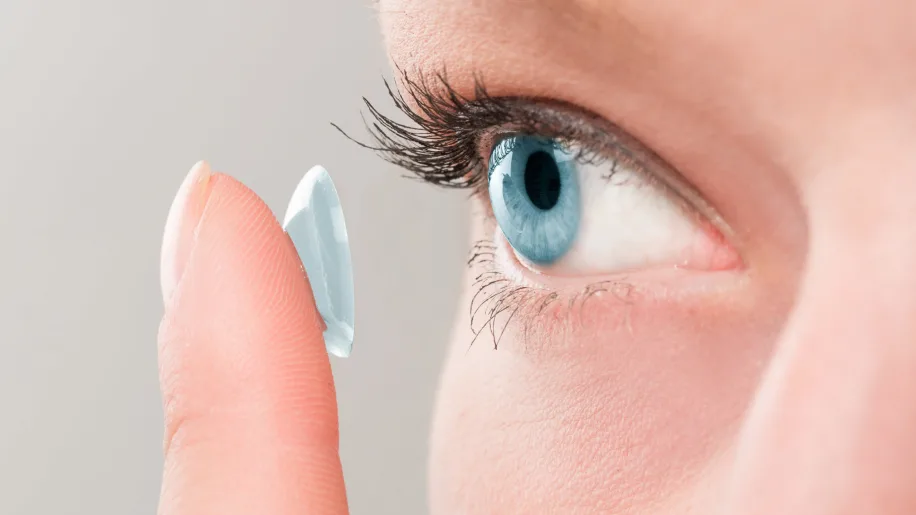What To Avoid When Using Contact Lenses

A lot of people who need to fix their vision choose contact lenses instead of glasses. They are thin, clear discs made of a certain kind of plastic that stick right to the eye’s surface. Astigmatism, nearsightedness, farsightedness, and presbyopia are all common eye problems that can be fixed with contact lenses. Compared to glasses, they give you a more natural look and a bigger field of view. There are different kinds of contact lenses, such as soft lenses, hard gas permeable lenses, and speciality lenses for certain eye diseases. They are convenient and flexible, so people who wear them can do many things without their glasses getting in the way. To avoid risks and keep your eyes healthy, it is important to take the right care and clean your eyes properly.
Advantages of Using Contact Lenses
Contact lenses are a useful alternative to glasses, and people who choose to wear them can benefit in a number of ways. One of the main perks is better vision, especially for people who already have certain eye problems. Because contact lenses sit right on the eye, they can fix refractive mistakes like nearsightedness and astigmatism more precisely and precisely.
Also, having contact lenses gives you a bigger field of vision than glasses. The lenses move with your eyes, so there are no flaws around the edges like there can be with frames. This means that people who wear them can see their surroundings more naturally and without any obstructions.
It’s also easy to do sports and other active activities with contact lenses. When you wear contacts instead of glasses, the lenses won’t fall off, break, or hurt you when you move around a lot. They provide a safe and stable way to fix vision, so people can do things like swimming, running, and playing physical sports without any worries.
Tips for Avoiding Common Mistakes when Using Contact Lenses
Contact lenses are convenient and let people avoid glasses, but people who wear them need to be aware of some common mistakes that can hurt their eyes and make them feel uncomfortable. By avoiding these common mistakes, people who wear contact lenses can make sure they have a safe and enjoyable experience while getting the best vision correction. This piece will talk about the most common mistakes people make when they wear contact lenses and give you advice on how to take care of and maintain them properly. People who wear contact lenses can reduce their chance of eye infections, corneal sores, and other problems by following these tips. This will let them get the most out of having contact lenses.
Not Cleaning Hands Before Handling Lenses
Good cleanliness is very important for people who wear contact lenses to keep their eyes healthy. Making sure your hands are clean before you touch your lenses is one of the most important parts of taking care of your contacts. If you don’t wash your hands, you can spread germs that can make you more likely to get an illness.
Before handling contact lenses, you should wash your hands well with soap and water to stop the spread of germs that could lead to eye illnesses. This will clean your hands of any dirt, oil, or germs that might be on them.
Wet your hands with clean, running water and then wash them with soap. Make sure to clean the backs of your hands, between your fingers, and under your nails by rubbing your hands together hard for at least 20 seconds. Run running water over your hands and dry them with a clean towel.
Remember that hand sanitisers like gels and wipes are not a replacement for soap and water. It’s possible that these items won’t get rid of all the germs on your hands, which could put your eye health at risk.
By making sure your hands are clean before handling your contacts, you can lower your risk of getting an infection and enjoy clear, easy vision. Remember that taking care of your eyes should always come first, so don’t skip this important step in good contact lens care.
Not Replacing Solutions Regularly and/or Using the Wrong Kind of Solution
Your eye health could get worse if you don’t change your contact lens solution regularly or if you use the wrong kind.
One effect is the chance of getting sick. Contact lens solution is meant to clean and germ-free your eyes, but it can lose its power over time. If you do not replace your solution often, you may be letting bacteria and other germs into your eyes, which can lead to painful eye illnesses.
If you use the wrong kind of contact lens solution, you might also feel pain and have trouble seeing. There are different ways to clean and cleanse different types of contact lenses, and using the wrong solution can hurt your eyes or damage the lenses. Making sure you follow the directions from the maker and talking to an eye doctor to find the right answer for your glasses is very important.
If you want to keep your eyes healthy, you need to change your contact lens solution as the maker tells you to and follow their directions. Changing your solution often and using the right kind will help lower your risk of infection and make sure that your eyes and comfort are at their best when you wear your contacts. Don’t risk your eye health; get the care you need and talk to a professional as soon as possible.
Wearing Contacts Too Long or Overnight
Unfortunately, wearing contact lenses for a long time or all night can be bad for your eyes. One of the main risks is that you are more likely to get eye diseases. If you wear your contacts for longer than the manufacturer recommends, bacteria and other germs have more time to build up on the lenses, which raises the risk of getting an illness.
If you wear your contacts for too long, you could end up with anything from mild pain to serious problems. When glasses are worn for long amounts of time, blurred vision is a regular problem. This happens because dirt and other particles get stuck on the lenses, making it hard to see clearly.
Another possible problem is corneal abrasions. You can scratch or damage the surface of the cornea if you leave contacts in your eyes for a long time. This can make you hurt, turn red, and be more sensitive to light.
When contacts are worn overnight, the chance of getting eye diseases like painful corneal sores is also much higher. These diseases can be very painful and even lead to vision loss. In the worst cases, a corneal transplant may be needed.
To keep your eyes healthy, it’s important to wear your contacts for the amount of time that the manufacturer suggests. Follow the steps your eye doctor gives you for taking out and cleaning your contacts at all times.
Swimming With Contacts In
When you swim with contact lenses in, your eyes can be in a lot of danger. One of the main worries is that eye diseases might happen. If you wear contacts while swimming, the lenses can soak up water that contains germs or other bugs that are bad for you. These can get stuck in your eye and make it more likely that you will get an infection.
Swimming with contact lenses on can cause infections as well as discomfort, swelling, and eye abrasions. There are chemicals and other impurities in pool water that can make your eyes red and irritated. Being around these irritants for a long time can also cause redness and eye abrasions, which are painful and can make it hard to see.
If you want to wear contacts while swimming, you might want to get daily disposables that you can throw away right afterward to avoid getting infections from the water.
Always put your eye health first by taking care of your contacts and keeping your hands clean. If you happen to feel pain, swelling, or have trouble seeing after swimming with contacts on, take them out right away and talk to your eye doctor.
Not Following Proper Disposal Instructions for Disposable Lenses
There is a chance of getting an infection if you don’t properly throw away throwaway glasses. Disposable lenses are only meant to be used for as long as the company that makes the lenses says they should be. It is important to follow these suggested usage times and throw away the glasses at the right time.
To keep your eyes healthy, it’s important to throw away throwaway glasses after the suggested use time. Keeping these lenses on for longer than suggested can make it more likely that bugs will get on them and cause eye illnesses. To keep things clean, you should follow the manufacturer’s specific directions on how to properly throw away contact lenses.
To avoid getting an illness, always follow the manufacturer’s guidelines for how to throw away your contact lenses. This includes using a new pair of lenses after the suggested amount of time has passed and putting away the throwaway ones. Properly throwing away throwaway lenses is an important part of caring for contact lenses and helps keep your eyes healthy.
People who wear throwaway lenses can reduce their risk of getting an illness and improve their eye health by following the directions for throwing them away.
Rubbing or Touching Eyes With Contacts Still In Place
If you rub or touch your eyes while wearing contact lenses, there are a number of risks and bad things that could happen. You should be aware of these risks and follow the right steps to stay away from them.
One of the main risks of hitting or rubbing your eyes while contacts are still in is that you could scratch or damage the lens. The cornea is the clear, protected skin on the outside of the eye. If it gets hurt, it can cause diseases or sores on the cornea. These conditions can be painful and may need medical help to get better.
It is important to know the signs that may mean you need to take out your contacts right away. If your eyes feel red, hurt, have confused vision, are sensitive to light, or tear a lot, you should take out your contacts right away. If you keep wearing the lenses in these scenarios, it can make the problem worse and raise the risk of more problems.
To avoid these problems, it is very important to treat contact lenses the right way. One way to do this is to not rub or touch your eyes while the glasses are in. When you rub your eyes, you can bring germs or other allergens into them, which can make infections or corneal sores more likely. To lower these risks, it’s important to keep your hands clean and be gentle when handling contact lenses.
The process of applying makeup while wearing contacts is discussed.
When putting on makeup while wearing contacts, safety should come first and the chance of eye pain or infection should be kept to a minimum. Here are some very important things to remember:
- Before putting on makeup, put in your contact lenses. This keeps bits of makeup from getting stuck between your eye and the lens.
- Before you touch your glasses or put on makeup, wash your hands very well. This makes it less likely that dirt, germs, or other allergens will get into your eyes.
- Choose makeup that is hypoallergenic and made with water. These are less likely to irritate the eyes or cause allergic responses than heavy or oil-based ones.
- Do not put eyeliner on your lines. The waterline is the inner edge of your eyes. Putting on makeup there makes it more likely that it will touch your lenses.
- Often change your eye makeup. Over time, mascara, eyeliner, and makeup can grow germs, so it’s best to get new ones every three months to avoid getting an infection.
You can safely improve your beauty while wearing contact lenses by adhering to these tips, which also reduces the likelihood of eye pain or discomfort. Remember to talk to your eye doctor if you have any special questions or worries.
Reusing Contact Lens Solutions that are Damaged, Old, or Out of Date
Reusing contact lens solutions that are old, broken, or out of date can be very bad for your eyes. To avoid eye diseases and corneal sores, it is important to always use new contact lens solution that hasn’t passed its expiration date.
Solutions that have passed their expiration date may not clean and disinfect your glasses properly. A lot of bacteria, dirt, and other germs can build up on your lenses this way, which makes getting eye illnesses more likely. Solvents that have gone bad may also not properly hydrate your lenses, which can make them hurt, feel dry, and make your vision blurry.
If you use contact lens solutions that are broken, like ones with leaks or broken seals, they can get dangerous germs and microorganisms into your lenses. This makes it a lot more likely that you will get painful illnesses and eye sores.
It is important to follow the directions given by the maker to make sure that your contact lens solutions are safe and work well. Keep solutions in a clean, dry place out of direct sunlight. Follow the directions for getting rid of any solutions that aren’t being used.
Your eye health is too important to risk with solutions that are out of date or broken. To keep eye infections and corneal sores to a minimum, always use new contact lens solutions and make sure you get the care you need.
Sleeping With Makeup On After Wearing Contacts
There are several risks and possible outcomes that could happen if you sleep with makeup on after wearing contact lenses. Makeup can easily get into contact lenses and make them dirty, which can increase the risk of eye diseases.
Makeup like mascara, eyeliner, and lipstick can have germs and other microorganisms that are bad for you in them. These germs can get on the contact lenses if they are left on overnight. The lenses create a warm and wet climate that is perfect for germs to grow. This makes eye illnesses like conjunctivitis and corneal sores more likely.
To avoid these problems, it is very important to take off your makeup before putting in your contacts. Do the first thing: wash your hands well with soap and water to keep from getting any more germs or dirt into your eyes. Then, gently take off all signs of makeup with oil-free makeup removers or cleaning wipes made for use around the eyes. You should stay away from items with oils because they can leave film on the lenses.
Taking off your makeup and cleaning your contacts properly are important for keeping your eyes healthy. By doing these things, people who wear contact lenses can lower the chance of getting an illness and keep their eyes safe.
Risks Associated with Poor Care of Contact Lenses
When you wear contact lenses, you need to take good care of them and keep them clean. Not taking the right safety steps can cause a lot of different risks and problems. Putting off taking care of your contact lenses can hurt your eye health in many ways, from eye diseases to corneal sores and blurred vision. This piece will talk about the different risks that come with not taking good care of your contact lenses and give you ways to avoid them. If you follow these tips, you can make sure that wearing them is safe and comfortable while also keeping your eyes healthy.
Eye Infections and Corneal Ulcers
Some types of eye diseases, like bacterial, viral, and fungus illnesses, are more likely to happen to people who wear contact lenses. Bad lens care can leave tiny scratches on the eye, which can make it easier for these infections to spread.
It is very important to clean and cleanse contact lenses the right way to lower the risk of getting eye infections and corneal sores. When you clean your glasses, don’t use tap water or soapy water because they might have germs in them that can make you sick. Always use new contact lens solution and never use old solution again. Make sure you wash your hands well before touching your lenses, and never swim or use a hot tub with your lenses on.
People who wear contact lenses should also do what their eye doctor tells them to do to take care of and wear their lenses. Getting regular checkups and following the right ways to clean and throw away things can greatly lower the chances of getting painful corneal sores and dangerous eye infections. Remember that taking care of your eyes means taking care of your contact lenses.
Blurred Vision and Corneal Abrasions
If you don’t take good care of your contact lenses, you could get blurred vision and damage to your eye. These uncomfortable and possibly dangerous eye conditions can happen if you don’t clean, change the solution in your lenses, or throw them away properly.
Plaque and germs can build up on the surface of contact lenses if they are not cleaned properly or if they are handled with dirty hands. This can cause blurred vision because the garbage gets in the way of correcting your vision. Also, if you don’t clean your lenses with new contact lens solution, germs can grow and cause infections in your eyes, which can damage the cornea.
When the skin of the eye is scratched or broken, this is called a corneal abrasion. When glasses are put in without being properly cleaned, dirt that gets stuck between the lens and the eye can cause pressure and wear. These cuts and scrapes can be painful and may make it harder to see.
To avoid these risks, it is very important to take good care of your lenses. Before touching lenses, make sure your hands are really clean, and never use old or broken contact lens solutions again. Every time, put a new solution in the lens case instead of the old one. Also, it’s important to throw away your contact lenses according to the instructions that came with them, whether they are daily disposables or meant to be worn for a longer time.
People who wear contact lenses can lower their risk of getting blurred vision and eye abrasions by making sure they clean, change, and throw away their lenses properly. Getting regular eye exams and doing what an eye doctor tells you to do are also important for keeping your eyes healthy.
Conclusion
Finally, here are some mistakes that people who wear contact lenses should not make. It is dangerous to swim or use hot tubs with contact lenses because water from taps, swimming pools, and even soapy water can have bacteria that are harmful. Also, it’s important not to refill or top off old contact lens solutions because this can bring in germs that can make eye illnesses more likely. Finally, keep your corneas from getting scratched by rubbing or touching your eyes while contacts are in.





